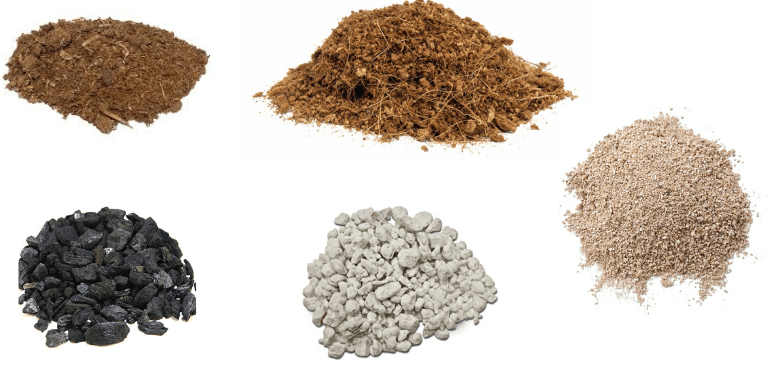
When most people think of hydroponics gardening they visualize rows of plants with roots dangling in moving water. After all, ‘hydroponics’ means ‘water’ and ‘labor’ or a method of growing plants without soil. Plants do not need soil to grow properly; they just need the mineral salts within the soil to grow – and ‘mineral salts’ is just another term for ‘fertilizer’. Soil by itself is really only useful for anchoring a plant.
There are many ways to grow a plant without using soil and a row of plants with roots dangling in moving water is just one way. Other ways use growing mediums or substrate that are not too dense and have good drainage.
A hydroponics growing medium acts as an anchor to the plant so it does not fall over as it grows, provides good drainage of nutrient solution and allows the flow of oxygen to the plant roots.
Almost anything can be used as a growing medium if it meets these basic requirements:
- It must be reasonably dense to provide enough weight and mass to anchor a plant but it cannot be too dense or it will impede the flow of oxygen and nutrient solution.
- It must be clean and/or sterile to impede the spread of disease and pests.
- Each individual growing medium ‘nugget’ must be small enough to provide a larger amount of surface area to remain damp with nutrient solution between flooding to allow the plant to feed.
- It must be of a neutral pH (we do not want pH problems).
- It should be easy to work with.
At this point you may be asking, “Why go the hydroponics route at all if I need to use a growing medium, why not stick with the simpler and less complex, ‘tried and true’ dirt gardening where soil is my growing medium?”
You could…there is certainly nothing wrong with dirt gardening except that soil always becomes packed down and too dense to be of good use.
The sad truth is that most of the fertilizer you spread around your plants is either leached or washed away. To fertilize your dirt garden plants to the level hydroponics achieves you would have to apply a toxic amount, burning the upper roots just to feed the lower ones.
Now back to growing mediums. My current favorites are Leca clay pellets and pea stone. The clay pellets are commercially made small, marble-sized balls of kiln-fired clay. They are light in weight and density, clean and very easy to work with. Because they are not very dense I use them in systems containing small containers, one per plant, where the container itself helps stop a growing plant from toppling. For this they are ideal.
Pea stone is great for larger containers each containing several plants. It is cheap, dense and readily available. On the negative side it is extremely heavy, very dirty and could change your nutrient solution’s pH fairly quickly. Before use I rinse the pea stone by shoveling it into a wheelbarrow and hosing it down until the water runs clear (it is an exhausting job). It comes in small 40 lb. bags.
There are many excellent commercially made mediums especially designed for hydroponics all of which I would recommend.
- Leca clay pellets – described above. Also marketed as Hydroton.
- Hygromite – Silica based mineral rock that is kiln dried into small stone size pebbles. It is 100% organic and not too expensive but, as a downside, must be rinsed to clean the constant dust it erodes.
- Rockwool – very popular medium made from melting igneous rock and dripping it onto a spinning disk to dry (like cotton candy). It’s readily available but somewhat dirty and it produces a dust when setting it up which is not something you want to breathe. It also comes in grow cube form.
- Grow Cubes – made from compressed fibers of cocoa, wood, peat or rockwool just to name a few. They have excellent water retention and are used for propagating seedlings from seeds. The seedling and the entire cube can be easily dropped into a hydroponics system ‘as is’ when ready. My only problem with these (and entirely my fault) was a higher incidence of ‘damping-off’ disease due to the fact that these cubes never dried out for me – maybe I should have cut back on my watering…
- Rocks – pea stone is mentioned above and is commercially available or you can use small rocks you find outside. Remember that the smaller the rock, there is more total surface area to hold moisture so the growing medium will not dry out as fast. When using pea stone or any rocks for that matter, minerals could leach off into the nutrient water changing the pH rather quickly which is not a good thing for your plants.
You can make your own growing medium using combinations of rocks, sand, perlite, vermiculite, peat moss, sawdust, styrofoam, paper, cardboard or anything you could possibly think of. But just because it is possible to use styrofoam or paper, for example, as a growing medium it does not mean you should use these materials. Be aware that different materials will leach off minerals and even toxins over time that could have adverse effects on your plant as well as on you.
So pick a growing medium using good judgment and always be on the lookout for any possible problems. The key word here is to ‘experiment’…
Larry Maki is an avid, self-taught hydroponics gardener from Connecticut with a passion for alternative types of gardening.
Related Articles & Free Email Newsletter
5 Things to Consider Before Purchasing LED Grow Lights



Comment here